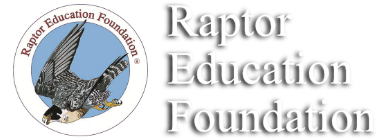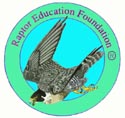 VirtualREF
VirtualREF
Last revised: December 08, 2010 Raptors Visit Boadicea
Falcons In Aurora
Killers At DIA
Breckenridge Riverwalk Theatre
Trinidad Tour
REF to Kansas
Bubos Are Back see video of the babies
Alaskan Return
Dillon Nature Nights
Bubo Spring
REF Receives “10 Best“ Award
Award 
 Join Our Anything Raptor Network: It’s Free!
Join Our Anything Raptor Network: It’s Free!
Denver, Oct 20, 2007: Want to visit one of the selected 10 best destinations for “Going Green” in Denver, Colorado? Just read about our most recent award from an organization that evaluates such things without the entity under consideration knowing that they are being reviewed by the 10 Best editorial board. 10 Best serves 40 million international travelers with their discerning reviews and reports of the best places in over 3,000 cities world wide. Nobody can ever pay to be included in their listings. We may be small, but we are mighty good, and when you look at the company we are found in, and those not included, we think that says a lot. Thanks to our members, sponsors, Docents, volunteers, and staff that obviously contributed to REF receiving this internationally important designation. Just click…
REF Raptors in New York City
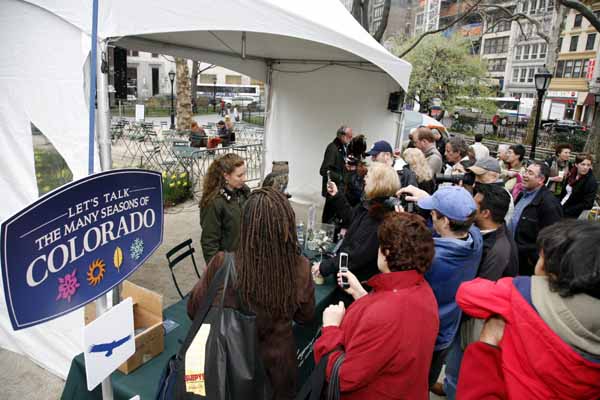 REF officials and 3 birds represented Colorado’s wild tourism opportunities in a $200,000 tourism promotion in New York City this past March, 2008. Despite the cold spring weather, New Yorkers joined lots of international tourists and visited REF’s display in Madison Square Park.
REF officials and 3 birds represented Colorado’s wild tourism opportunities in a $200,000 tourism promotion in New York City this past March, 2008. Despite the cold spring weather, New Yorkers joined lots of international tourists and visited REF’s display in Madison Square Park.  Raptors in the Wild with REF
Raptors in the Wild with REF
January 18, 2008: One of our clients on the consulting side of our operations is Frontier Airlines. Frontier has made wildlife quite famous by placing a variety of species on the tails of their airplanes and they actually have a pair of great-horned owls living in the hangar in which the company services its planes. Both owls are monitored by us in addition to our managing their pigeon pest problem for the past 18 months. We have recorded some amazing stories as this pair of owls lives and hunts within the confines of the very large hangar. Here one of the owls is seen outside perched on the hangar wall.
Mechanics have actually seen the owls taking pigeons in mid-air within the hangar. I have confirmed their hunting prowess by watching the pair working cooperatively to take a pigeon off of the top of some pipes about 90 feet up in the hangar. The entire process took place over the course of an hour at about 11:30 am. Not necessary to adhere to a strictly crepuscular schedule for these technologically friendly Bubos.
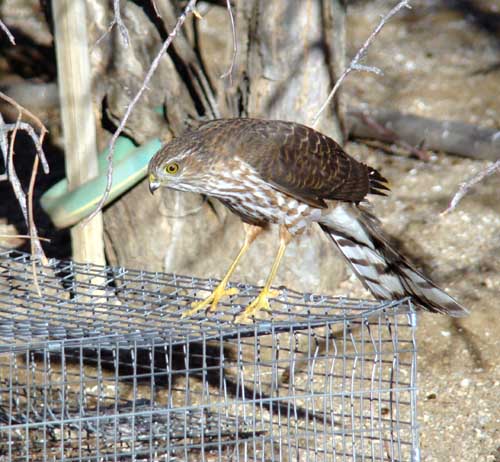 Trapping House sparrows at our facility often attracts the attention of one of the visiting sharp-shinned hawks. This particular visitor gave us a chance to get some great photos and some video footage. To see how quick these tiny little accipiters are, just click on our video link.
Trapping House sparrows at our facility often attracts the attention of one of the visiting sharp-shinned hawks. This particular visitor gave us a chance to get some great photos and some video footage. To see how quick these tiny little accipiters are, just click on our video link.
Photos by P. Reshetniak
Urban Prairie Making History?
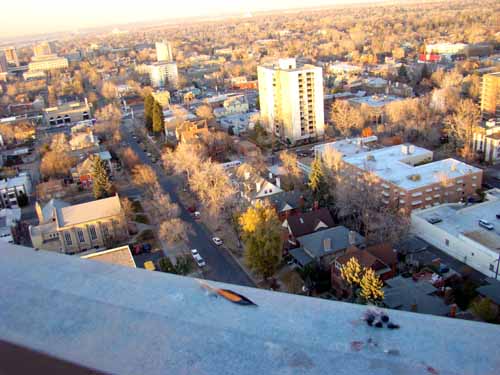 A view to kill…from the top of Park Towers (22 stories) where the prairie falcon had finished its feast, the view was delicious. See more photos below.
A view to kill…from the top of Park Towers (22 stories) where the prairie falcon had finished its feast, the view was delicious. See more photos below. 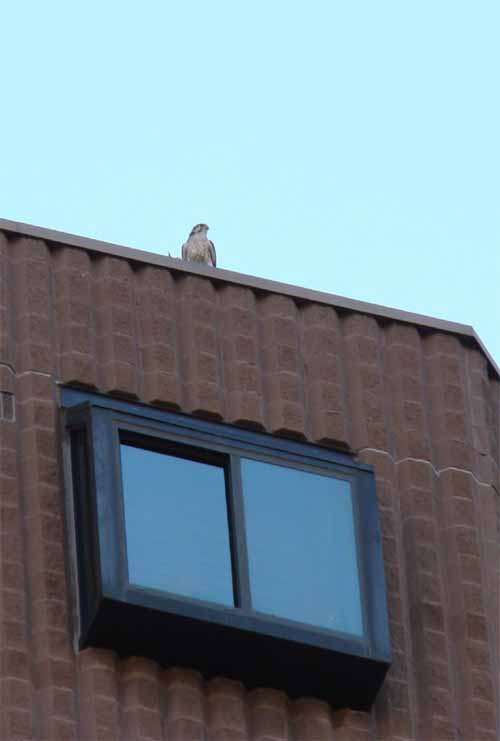 Only after watching the big falcon land, did I realize that it was carrying its kill. After perching on top of the Park Towers complex, looking around to see if it was safe, the prairie falcon began to pluck and eat its city meal.
Only after watching the big falcon land, did I realize that it was carrying its kill. After perching on top of the Park Towers complex, looking around to see if it was safe, the prairie falcon began to pluck and eat its city meal. 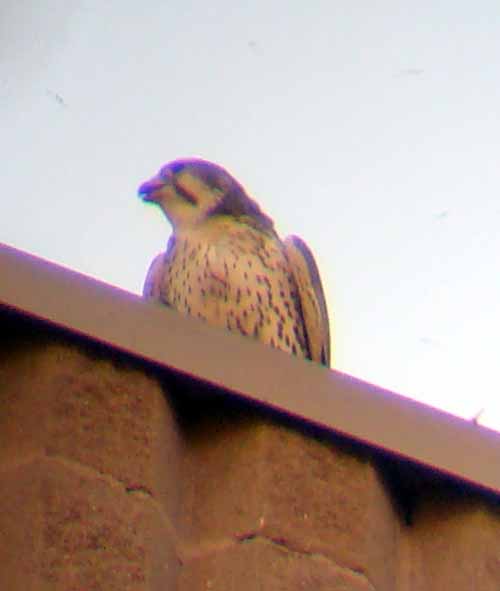 scouting the air space around it….making sure nobody else was around to steal the colorful meal.
scouting the air space around it….making sure nobody else was around to steal the colorful meal. 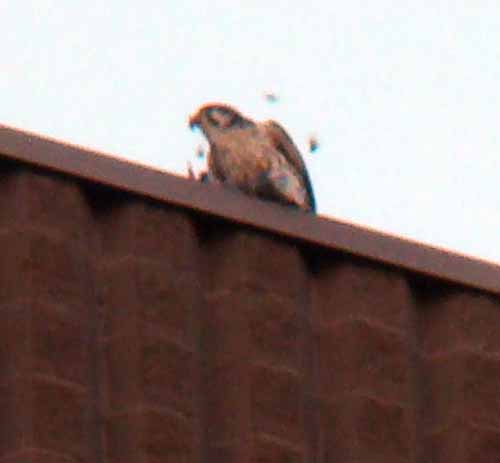 Feathers flying as I capture some digital images through a spotting scope from the street below.
Feathers flying as I capture some digital images through a spotting scope from the street below. 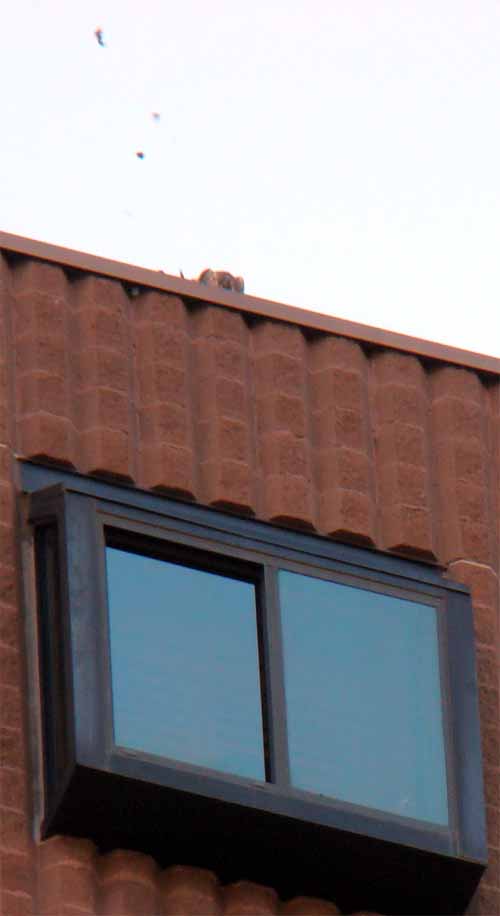 ….feathers flying from a fabulous feast…
….feathers flying from a fabulous feast… 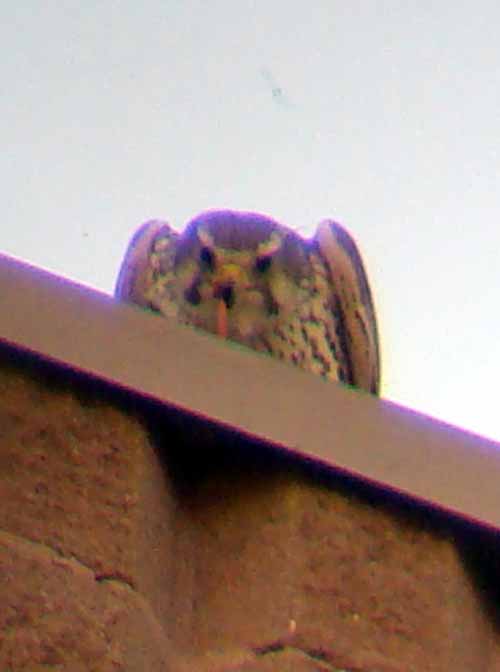 Birding in the city can be very rewarding for the patient observer. I have been coming to the high condominium towers on the north side of Cheesman Park for over 5 years when I first learned of a peregrine falcon roosting on one of the buildings at 13th and Williams. Last week, wanting to show a visitor to Denver I came back for a look, and at first without anything but my eyes in late afternoon light, I thought we were in luck and were viewing the peregrine at roost. But when I glassed the perched falcon, I realized it was a prairie falcon. However, bad light prevented a confirmation until I was able to come back with spotting scope and camera on November 14, 2007. We would appreciate information from anyone who has seen this species in an urban environment. Update: 11/16/07: See other urban prairie photos below
Birding in the city can be very rewarding for the patient observer. I have been coming to the high condominium towers on the north side of Cheesman Park for over 5 years when I first learned of a peregrine falcon roosting on one of the buildings at 13th and Williams. Last week, wanting to show a visitor to Denver I came back for a look, and at first without anything but my eyes in late afternoon light, I thought we were in luck and were viewing the peregrine at roost. But when I glassed the perched falcon, I realized it was a prairie falcon. However, bad light prevented a confirmation until I was able to come back with spotting scope and camera on November 14, 2007. We would appreciate information from anyone who has seen this species in an urban environment. Update: 11/16/07: See other urban prairie photos below
The Board of Park Towers has also just informed us that they would be amenable to place a nest box atop their building, which opens up some interesting possibilities of attracting one of the peregrines that regularly roost next door (see above), or maybe enticing this prairie falcon. The latter would be a first to ever accept an urban nest box, while peregrines have been doing so for decades.
Our sincere thanks to Mr. Jan Stineman, facility manager, who invited us in to get on the roof, and keeping us informed for all these years about the visiting peregrines on the other buildings in the immediate area.
Peter Reshetniak
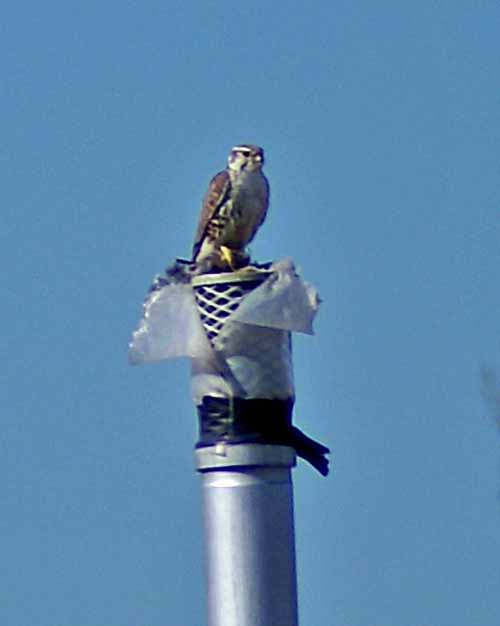 Another urban prairie falcon seen by Carol Blackard on February 22, 2007 in the city of Centennial, Colorado south of Dry Creek Road and the intersection of south Adams & south Monroe street. The falcon appears to be sitting on a vent pipe. Photo courtesy of Ms. Blackard…many thanks. This area is a little more sub-urban than the sighting off of Cheesman Park.
Another urban prairie falcon seen by Carol Blackard on February 22, 2007 in the city of Centennial, Colorado south of Dry Creek Road and the intersection of south Adams & south Monroe street. The falcon appears to be sitting on a vent pipe. Photo courtesy of Ms. Blackard…many thanks. This area is a little more sub-urban than the sighting off of Cheesman Park. 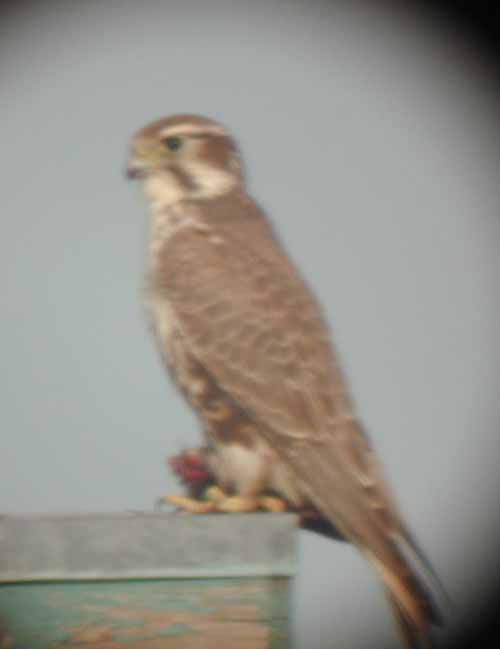 From a birder in Omaha, Nebraska, about 3 years ago, John Hall sends us this picture of an urban prairie he spotted. Many thanks to Mr. Hall who remarks that this bird was probably “wee east” of its normal range.
From a birder in Omaha, Nebraska, about 3 years ago, John Hall sends us this picture of an urban prairie he spotted. Many thanks to Mr. Hall who remarks that this bird was probably “wee east” of its normal range.
Raptors at Boadicea
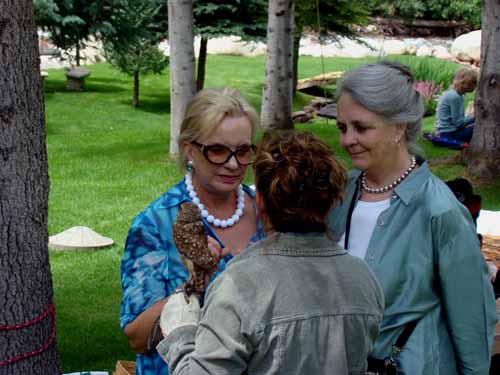 Toni Smith, Senior REF Docent, spent a great deal of time up close and personal with REF’s brand new ambassadorial burrowing owl and the guests at Boadicea. This little fellow had been found March 27, 2007 at Denver International Airport after a severe windstorm. It is thought the wind had slammed the owl into a large smooth surface and the resulting trauma detached one of the owl’s retina’s resulting in partial blindness. This condition precludes the owl ever being returned to the wild.
Toni Smith, Senior REF Docent, spent a great deal of time up close and personal with REF’s brand new ambassadorial burrowing owl and the guests at Boadicea. This little fellow had been found March 27, 2007 at Denver International Airport after a severe windstorm. It is thought the wind had slammed the owl into a large smooth surface and the resulting trauma detached one of the owl’s retina’s resulting in partial blindness. This condition precludes the owl ever being returned to the wild. 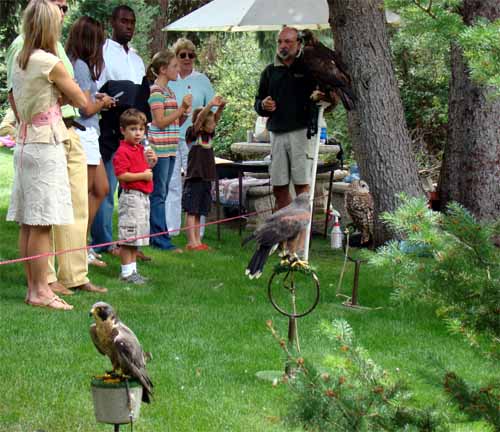 REF’s display, adjacent to Castle Creek, attracted the guests to view and learn about a golden eagle, a Harris’s Hawk, a barred owl, and a peregrine falcon in addition to the little burrowing owl who stole the show. A mother Dipper flew up and down the creek busily foraging for food while feeding her two offspring as they chased her with their piercing food begging calls. Their high pitched voices could easily be heard over the tumbling waters, and their “dipping” antics were sure to make anyone laugh who chanced upon their bobbing up and down on the middle of a rock in the fast flowing waters.
REF’s display, adjacent to Castle Creek, attracted the guests to view and learn about a golden eagle, a Harris’s Hawk, a barred owl, and a peregrine falcon in addition to the little burrowing owl who stole the show. A mother Dipper flew up and down the creek busily foraging for food while feeding her two offspring as they chased her with their piercing food begging calls. Their high pitched voices could easily be heard over the tumbling waters, and their “dipping” antics were sure to make anyone laugh who chanced upon their bobbing up and down on the middle of a rock in the fast flowing waters. 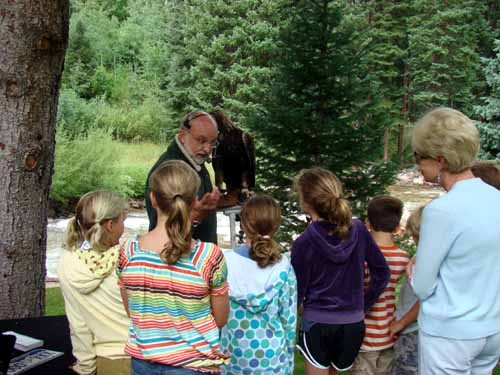 An attentive audience gathers around Peter Reshetniak, REF President, as he talks about the male golden eagle he is holding.
An attentive audience gathers around Peter Reshetniak, REF President, as he talks about the male golden eagle he is holding. 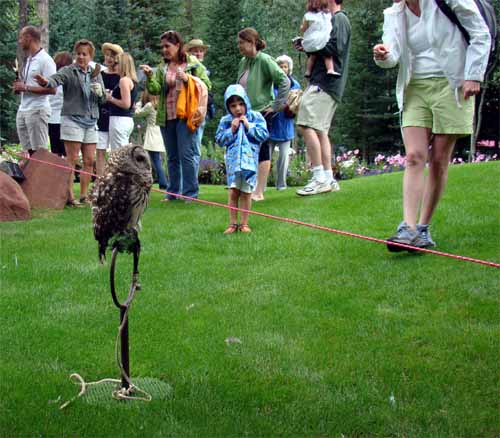 Harry Potter fans flocked to see the two very different owls REF displayed at Boadicea. Here, a male barred owl stopped one young man in his tracks….
Harry Potter fans flocked to see the two very different owls REF displayed at Boadicea. Here, a male barred owl stopped one young man in his tracks…. 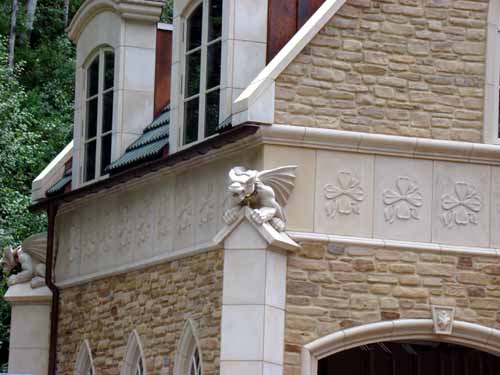 Taking over two years to construct her summer residence, Mary Ralph Lowe paid exquisite attention to the details that would connect her home’s feel and appearance to the history and legend of her estate’s namesake, Boadicea. The setting and the craftsmanship of the unique home quickly transports the viewer back to a time when eternal verities made themselves known through artistic expressions in architectural excellence.
Taking over two years to construct her summer residence, Mary Ralph Lowe paid exquisite attention to the details that would connect her home’s feel and appearance to the history and legend of her estate’s namesake, Boadicea. The setting and the craftsmanship of the unique home quickly transports the viewer back to a time when eternal verities made themselves known through artistic expressions in architectural excellence.
All photos by Marie Bolster
A Lifetime Studying & Representing Wildlife…
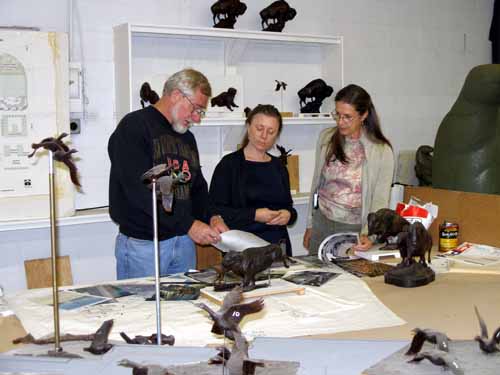 REF Board Member, Marie Bolster (right) listens with Nancy Malick, artist/illustrator, as Kent Ullberg N.A. reviews some of his notes and plans related to the “maquette” spread on the table before them. The model depicts what is probably the world’s largest piece of wildlife sculpture installed anywhere, and is the actual piece Ullberg submitted to win the wildlife portion of the commission.
REF Board Member, Marie Bolster (right) listens with Nancy Malick, artist/illustrator, as Kent Ullberg N.A. reviews some of his notes and plans related to the “maquette” spread on the table before them. The model depicts what is probably the world’s largest piece of wildlife sculpture installed anywhere, and is the actual piece Ullberg submitted to win the wildlife portion of the commission.
This composition in metal is part of a redevelopment project in Omaha, Nebraska, and funded by a local family owned bank with historic ties to the area. Aspects of Kent’s design include larger than life size geese and bison integrated into the cityscape and directly into the buildings themselves.
The multi-year project covers numerous city blocks of a once blighted area. Two other sculptors are adding “pioneer” elements to another part of the composition. Ullberg has just about completed his part of the project representing the wildlife once common to the area, and now displaced by the growing metropolis.
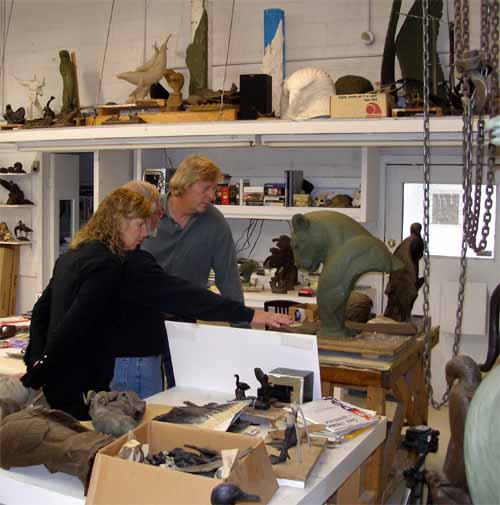 Ragnhild Jonsson looks on with her husband Lars (Swedish bird painter extraordinaire) as Kent describes some of his other works. Lars and Ragnhild had just arrived from Sweden and were joining up with Kent and his wife Veerle to head north for the annual National Wildlife Art Museum show in Jackson Hole, Wyoming.
Ragnhild Jonsson looks on with her husband Lars (Swedish bird painter extraordinaire) as Kent describes some of his other works. Lars and Ragnhild had just arrived from Sweden and were joining up with Kent and his wife Veerle to head north for the annual National Wildlife Art Museum show in Jackson Hole, Wyoming. 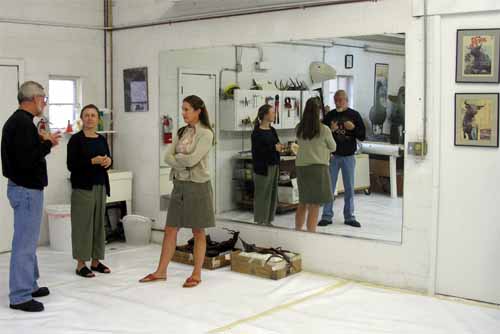 Kent spent quite some time explaining various points about the research he conducts when commissioned to create a specific piece for a client. This often involves consulting with paleontologists when he is asked to recreate and interpret from the fossil record.
Kent spent quite some time explaining various points about the research he conducts when commissioned to create a specific piece for a client. This often involves consulting with paleontologists when he is asked to recreate and interpret from the fossil record. 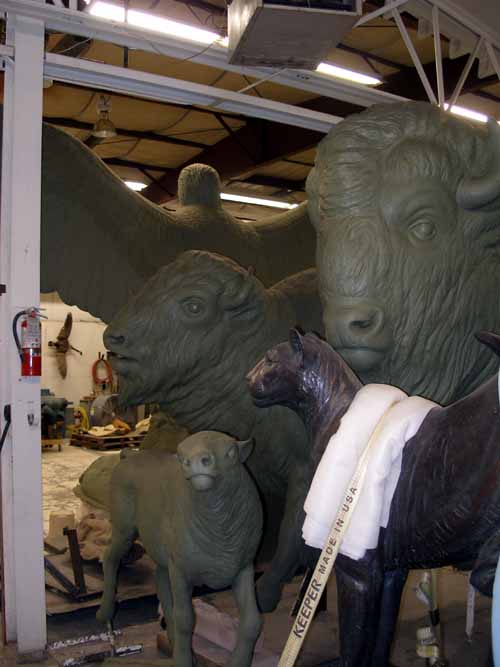 Finished clay models crowd one wing of the main Ullberg studio in Loveland. The lion in front has been poured in bronze and is one of the pieces traveling around to various museums in a retrospective show of Kent’s work.
Finished clay models crowd one wing of the main Ullberg studio in Loveland. The lion in front has been poured in bronze and is one of the pieces traveling around to various museums in a retrospective show of Kent’s work.
About Kent Ullberg
A native of Sweden, Kent Ullberg is recognized as one of the worlds foremost wildlife sculptors. While he has done hundreds of works on a small scale, he is perhaps best known for the monumental works he has executed for museums and municipalities from Omaha, Nebraska to Cape Town, South Africa. His Fort Lauderdale, Florida and Omaha, Nebraska installations are the largest wildlife bronze compositions ever done, spanning several city blocks. Regardless of scale, he imbues all of his subjects with unparalleled vitality.
Ullberg is a member of a number of important art organizations that have honored him with prestigious awards. These include, in New York City, Allied Artists of America, the National Academy, the National Arts Club, the National Sculpture Society and the Society of Animal Artists. In 1990, his peers elected him a full academician to the National Academy, the first wildlife artist since John James Audubon to receive one of the greatest tributes in American art. His memberships and awards outside New York include the American Society of Marine Artists, Ambler, Pennsylvania; and the National Academy of Western Art, Oklahoma City, which awarded him the Prix de West Award in 1998, the foremost award in western art. He is a major supporter of many wildlife conservation efforts.
Ullbergs work can be found in major museums and corporate headquarters around the globe, including the National Museum of Natural History in Stockholm, Sweden; the National Gallery in Botswana, Africa; National Geographic Society, Washington, D.C.; Exhibition Hall, Beijing, China; the Guildhall in London, and many more. His pieces can also be found in the private collections of world leaders and celebrities, including H.R.H. Prince Bernhard of the Netherlands, Jack Nicholson and Robert Wagner.
A Summit of Falcons in Aurora
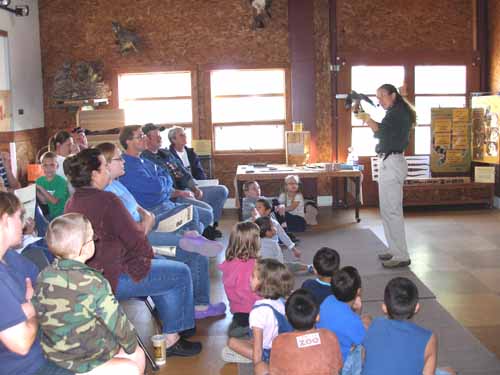 Anne Price, Curator of Raptors for REF, introduces the audience to the most common falcon in North America, the American Kestrel. The visitors learn about this gutsy four ounce falcon which lives everywhere from city to country, and is seen by almost everyone, yet few know of its predatory prowess.
Anne Price, Curator of Raptors for REF, introduces the audience to the most common falcon in North America, the American Kestrel. The visitors learn about this gutsy four ounce falcon which lives everywhere from city to country, and is seen by almost everyone, yet few know of its predatory prowess. 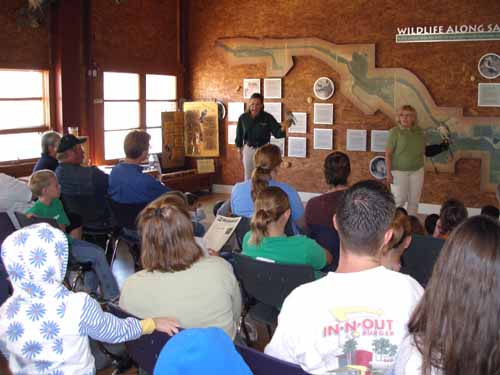 Visitors to the Morrison Nature Center see a direct comparison of the larger prairie falcon (right) to the American Kestrel.
Visitors to the Morrison Nature Center see a direct comparison of the larger prairie falcon (right) to the American Kestrel. 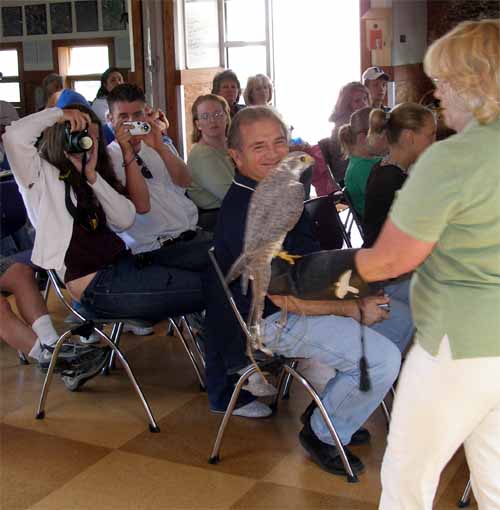 Margaret Catale, REF Senior Docent, takes the prairie falcon into the audience for close-up pictures and views, as Anne Price describes this falcon restricted to the prairie regions of North America, and commonly seen on the eastern plains of Colorado around the Morrison Nature Center in Aurora.
Margaret Catale, REF Senior Docent, takes the prairie falcon into the audience for close-up pictures and views, as Anne Price describes this falcon restricted to the prairie regions of North America, and commonly seen on the eastern plains of Colorado around the Morrison Nature Center in Aurora.
Killers At DIA
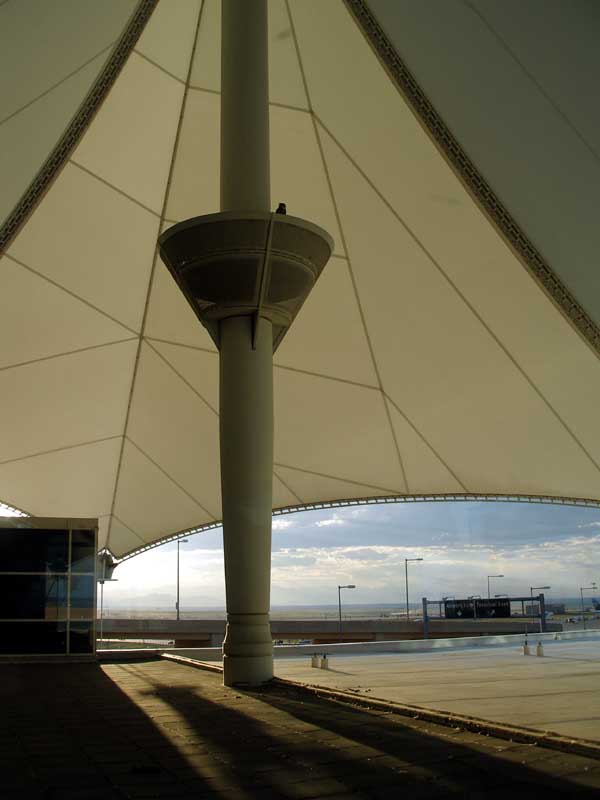
Travelers through Denver International Airport accessing Concourse A (Frontier Airlines) via the bridge over the taxiway who pay attention will be rewarded with a good look at one of the killers just outside the windows. Hanging out in plain site, on one of the support column collars, is one of a pair of great horned owls who regularly appear in the afternoons for a murderous aerial dance with the numerous pigeons who loiter in the area.
You do not have to go through security to see this little slice of nature. Just as you enter the bridge from the main airport terminal, look to the west or to the east and look up into the area shown here to the left (facing west) and you might get a glimpse of at least one of the pair. August 30, 2006, one of REF’s staff, returning from a trip, found the owls hanging out. The female, pictured here was on the west side, while the male was on the east side at the very top of the column. A couple of other travelers were also present to view the duo.
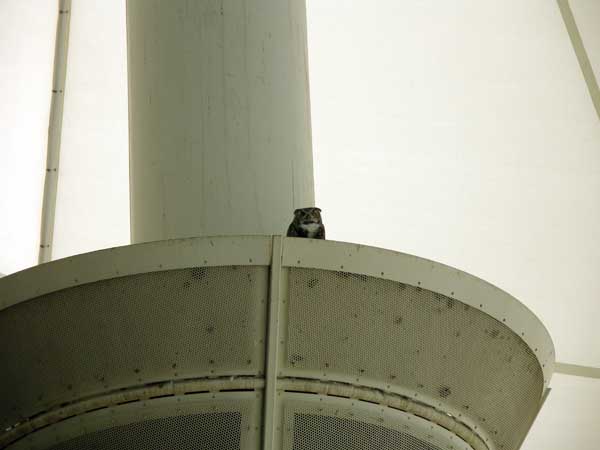 Zooming in for a closer view, the female was busy observing the activities all around her.
Zooming in for a closer view, the female was busy observing the activities all around her. 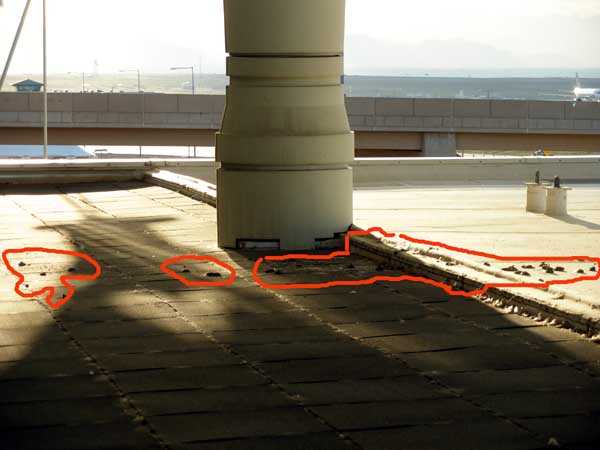 As with any crime scene, the outline reveal the evidence of the owl’s activities. Dozens of pellets or “castings” are visible to the naked eye at the base of the column. Forensic exams will no doubt, reveal pigeon parts as the main victims of the killer owls at DIA.
As with any crime scene, the outline reveal the evidence of the owl’s activities. Dozens of pellets or “castings” are visible to the naked eye at the base of the column. Forensic exams will no doubt, reveal pigeon parts as the main victims of the killer owls at DIA.
All photos: Peter Reshetniak
Raptors at Riverwalk Theatre in Breckenridge
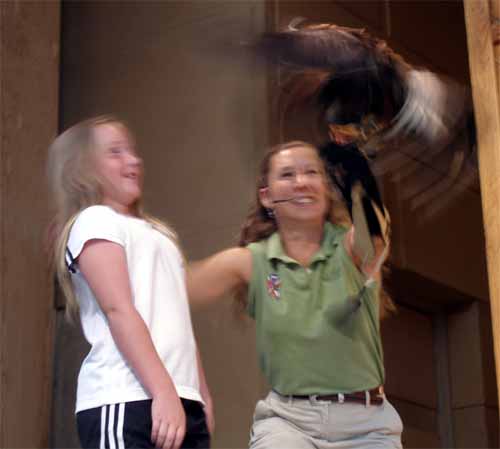 June 29, 2006 Breckenridge, Colorado: REF staff and birds presented one of our unique interactive environmental literacy programs that set some records for participation. Anne Price, REF’s Curator catches one of our Harris’ Hawks as it comes into land in front of a very impressed young participant in a blurrrr of action.
June 29, 2006 Breckenridge, Colorado: REF staff and birds presented one of our unique interactive environmental literacy programs that set some records for participation. Anne Price, REF’s Curator catches one of our Harris’ Hawks as it comes into land in front of a very impressed young participant in a blurrrr of action. 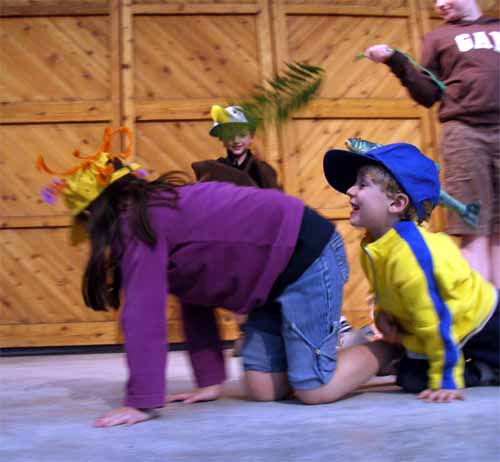 The action continues in our exclusive food pyramid role playing segment. One of the fish is about to turn a bug into a meal while the top predator, the bald eagle, approaches in the background.
The action continues in our exclusive food pyramid role playing segment. One of the fish is about to turn a bug into a meal while the top predator, the bald eagle, approaches in the background. 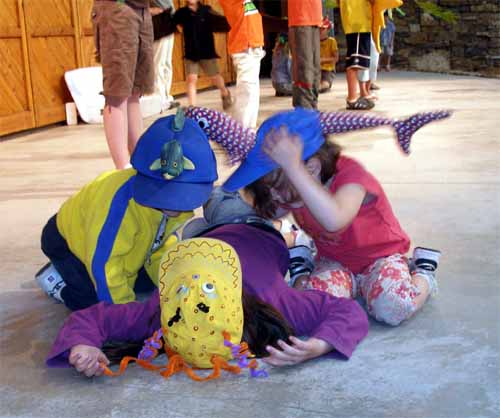 Another fish strikes the downed and helpless insect and the feeding frenzy ensues. This was one of the most enthusiastic group of predators REF has ever experienced.
Another fish strikes the downed and helpless insect and the feeding frenzy ensues. This was one of the most enthusiastic group of predators REF has ever experienced.  Yet the bald eagle trumps them all to come in to snag one of the fish. The food pyramid is one of the most memorable parts of our programs. Children, learn by creating a healthy biotic pyramid and then discovering what happens when just one player in the pyramid vanishes.
Yet the bald eagle trumps them all to come in to snag one of the fish. The food pyramid is one of the most memorable parts of our programs. Children, learn by creating a healthy biotic pyramid and then discovering what happens when just one player in the pyramid vanishes.
For 26 years, REF has led the way with its programs featuring live raptors to entice young people into the dynamic world of predator/prey relationships. See all that we offer to connect your audience to the natural world, and then join us to help create excitement for learning science to insure the continued health of our environment.
A Cure For Nature-Deficit Disorder
Richard Louv’s book, Last Child in the Woods: Saving Our Children from Nature-Deficit Disorder , describes what happens to children deprived of exposure to, and immersion in, nature’s living mystery of relationships. This philosophy has been secretly motivating REF’s mission long before the book was ever written. And as we here at REF like to say, “Their faces tell our story.” Travel with us on our most recent tour of our home state, Colorado, as we visit schools in the Trinidad area courtesy of a grant from the Bar NI Ranch Community Service Fund. Since 1999, REF has been working with the Bar NI Ranch, its managers and owners to assist them with raptor-related issues, and to use the ranch as a resource for the community in addressing the spread of Nature-Deficit Disorder (NDD). In those communities quite close to the natural world, one would think a natural immunity to NDD would exist. The assumption is incorrect. Large piles of cement, glass, and steel are obvious concentrations of NDD. The allure of cities is great in rural communities where economies are often lean, and technological effervescence seduces youth with GameBoys, “reality shows” and a wide variety of debilitating infections vectored into the country-side via cable and satellite. Quoting Richard Weaver, “The spoiling of man seems always to begin when urban living predominates over rural.” REF’s programs have been taking on these issues by using elemental forces of nature to reconnect those deprived from the beauty, wonder, and intelligence of the great mystery of creation in which all of us live, breathe, move, and have our being. Travel with us during the week of April 3rd, and see if you don’t agree that their faces tell our story, indeed.
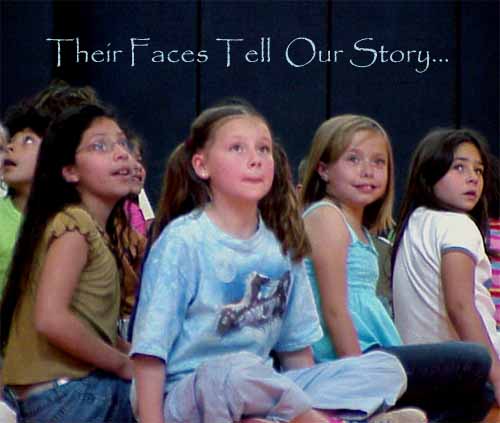 The magic of REF’s environmental literacy performances are best described in the faces of our audiences. We cannot improve on what these young ladies, and the young men below are saying. Almost 1,200 children and adults benefited from the programs underwritten by the Bar NI Ranch Community Service Fund grant. Future programs are being planned.
The magic of REF’s environmental literacy performances are best described in the faces of our audiences. We cannot improve on what these young ladies, and the young men below are saying. Almost 1,200 children and adults benefited from the programs underwritten by the Bar NI Ranch Community Service Fund grant. Future programs are being planned. 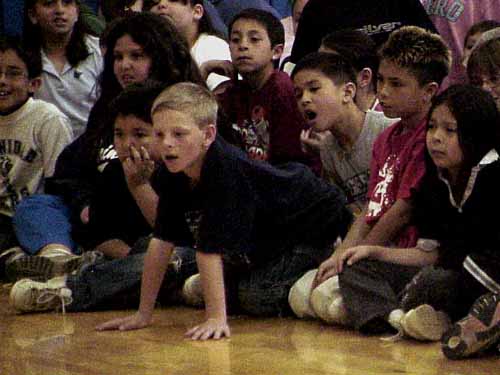 Wow, that’s why the Harris’ Hawk flies…cool, gross, yuck!!
Wow, that’s why the Harris’ Hawk flies…cool, gross, yuck!! 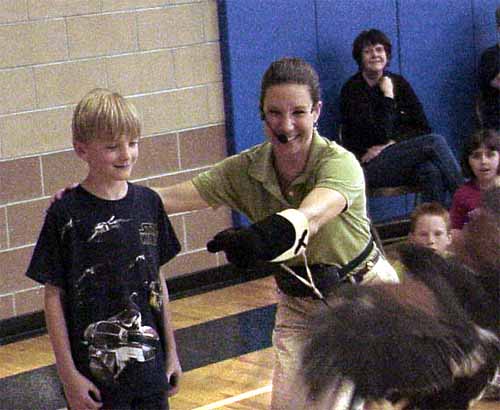 A blur of wings, a rush of air, talons grip, as raptors come to life with millions of years of history bringing them here–Jurassic Park in your gym.
A blur of wings, a rush of air, talons grip, as raptors come to life with millions of years of history bringing them here–Jurassic Park in your gym. 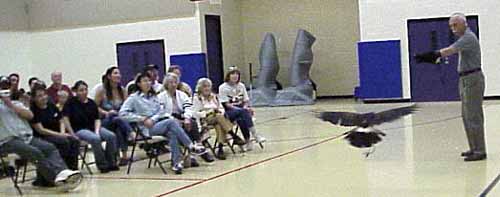 An evening program at the Trinidad Community Center let adults enjoy what their children had been experiencing during the day. 97 people came to listen and learn about raptors, and everything that connects them into the community of humans, and humans to the larger bio-community of life.
An evening program at the Trinidad Community Center let adults enjoy what their children had been experiencing during the day. 97 people came to listen and learn about raptors, and everything that connects them into the community of humans, and humans to the larger bio-community of life. 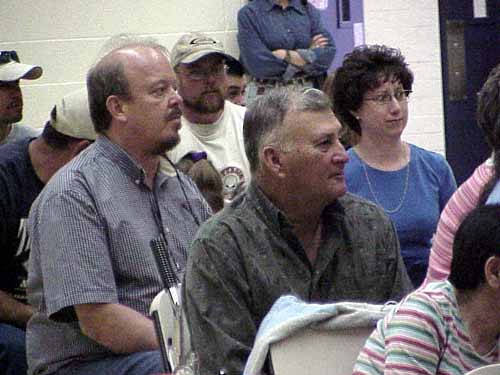 Our community program rewarded the adults by giving away REF’s exclusive Colorado Respects Wildlife license plate memberships to 3 lucky people who answered questions posed by REF’s Curator, Anne Price, as she engaged everyone into the performance. Congratulations to our winners! REF created and implemented the only environmental license plate in Colorado that spreads respect for the environment and wildlife as you drive.
Our community program rewarded the adults by giving away REF’s exclusive Colorado Respects Wildlife license plate memberships to 3 lucky people who answered questions posed by REF’s Curator, Anne Price, as she engaged everyone into the performance. Congratulations to our winners! REF created and implemented the only environmental license plate in Colorado that spreads respect for the environment and wildlife as you drive. 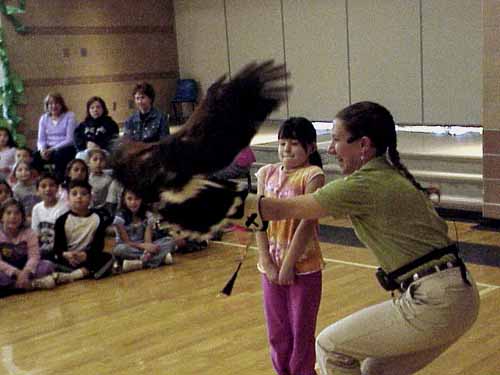 The essence of REF’s programs captured in the moment a free flying raptor lands just inches away from a volunteer–in this case a young lady whose courage was tested, her fear overcome. She expanded her limits, and rewarded her curiosity with an experience she will never forget.
The essence of REF’s programs captured in the moment a free flying raptor lands just inches away from a volunteer–in this case a young lady whose courage was tested, her fear overcome. She expanded her limits, and rewarded her curiosity with an experience she will never forget. 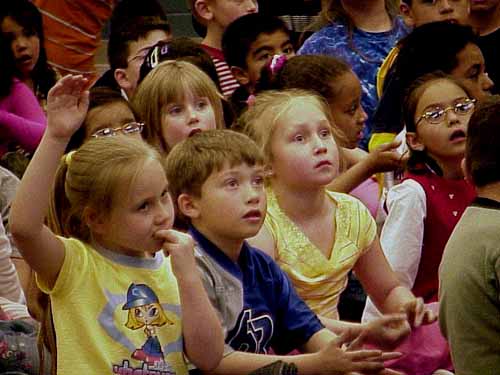 Little kids rarely let their curiosity be stifled by peer pressure, ego, or other social restraints. They just want to know.
Little kids rarely let their curiosity be stifled by peer pressure, ego, or other social restraints. They just want to know. 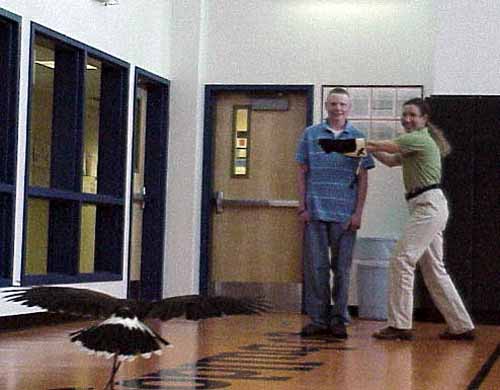 Even “big kids” in high school who tend towards complete submission to things like peer pressure, ego, and general “coolness”, drop their pretensions and get with the moment. Maybe the three foot wing span heading your way can get your attention too.
Even “big kids” in high school who tend towards complete submission to things like peer pressure, ego, and general “coolness”, drop their pretensions and get with the moment. Maybe the three foot wing span heading your way can get your attention too. 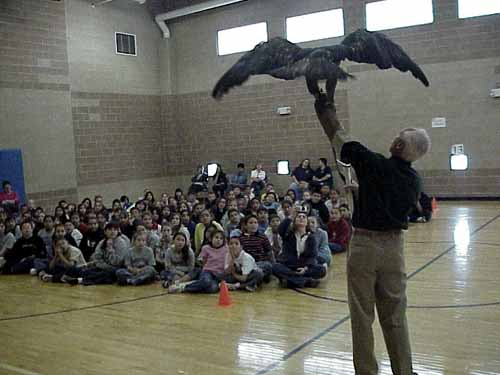 Six foot wing spans on golden eagles have a way of getting everyone focused on nature. Kevin Corwin, one of REF’s Senior Docents, displays REF’s twenty five year old female golden eagle to students at Fisher’s Peak Elementary.
Six foot wing spans on golden eagles have a way of getting everyone focused on nature. Kevin Corwin, one of REF’s Senior Docents, displays REF’s twenty five year old female golden eagle to students at Fisher’s Peak Elementary. 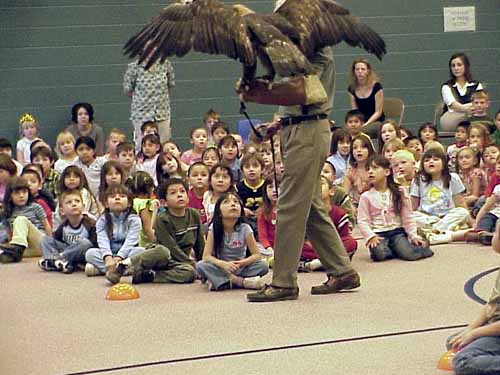 Just inches away, our golden eagle commands attention and respect.
Just inches away, our golden eagle commands attention and respect. 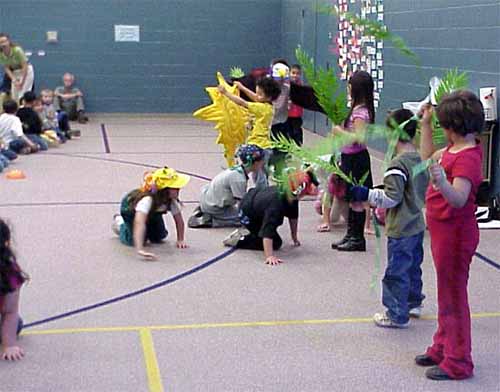 REF’s programs feature an exclusive interactive role-playing segment recreating a biotic pyramid to understand the interconnected community that sustains life. Experiencing these predator/prey relationships provides connections that mere words can never duplicate.
REF’s programs feature an exclusive interactive role-playing segment recreating a biotic pyramid to understand the interconnected community that sustains life. Experiencing these predator/prey relationships provides connections that mere words can never duplicate. 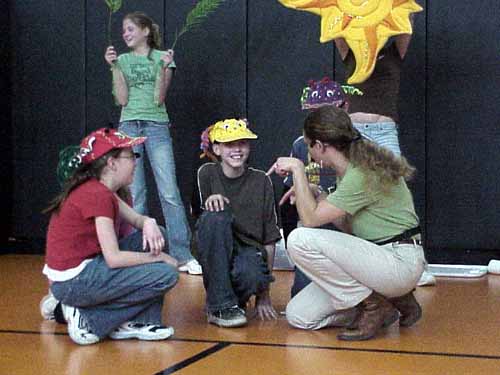 A “bug huddle” provides instructions to aquatic insects before they join their river of life.
A “bug huddle” provides instructions to aquatic insects before they join their river of life. 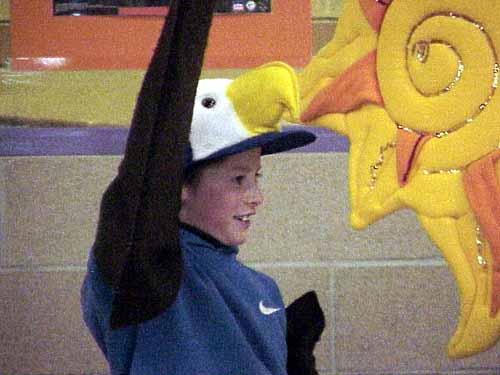 …and our bald eagle raises a wing in triumph.
…and our bald eagle raises a wing in triumph. 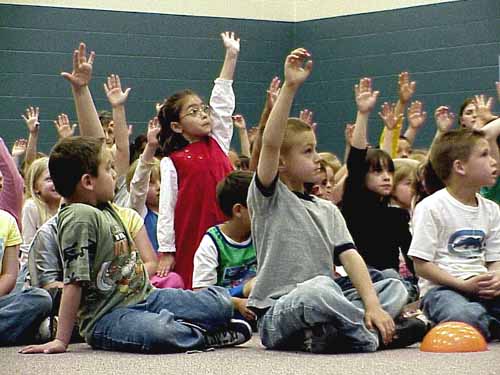 REF’s wildlife performances never fail to engage hands-on participation, and the call for volunteers rarely goes unheeded. Nature-Deficit Disorder has remedies, and all of them start when we facilitate connecting children to their curiosities in a real tangible way. Oh, and by the way for any eggheads out there, research confirms that these types of connections significantly improve CSAP scores.
REF’s wildlife performances never fail to engage hands-on participation, and the call for volunteers rarely goes unheeded. Nature-Deficit Disorder has remedies, and all of them start when we facilitate connecting children to their curiosities in a real tangible way. Oh, and by the way for any eggheads out there, research confirms that these types of connections significantly improve CSAP scores.  It all begins with a sense of awe, and
It all begins with a sense of awe, and 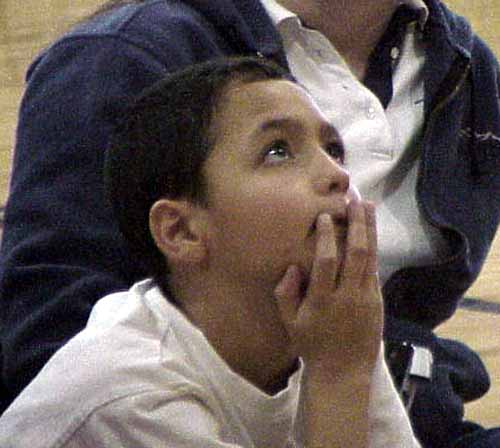 a sense of wonder…let REF replenish your deficit. We’ve been doing it for 26 years. Thanks to our partner, the Bar NI Ranch , and ranch managers, Linda and Tom Perry.
a sense of wonder…let REF replenish your deficit. We’ve been doing it for 26 years. Thanks to our partner, the Bar NI Ranch , and ranch managers, Linda and Tom Perry.
To Kansas
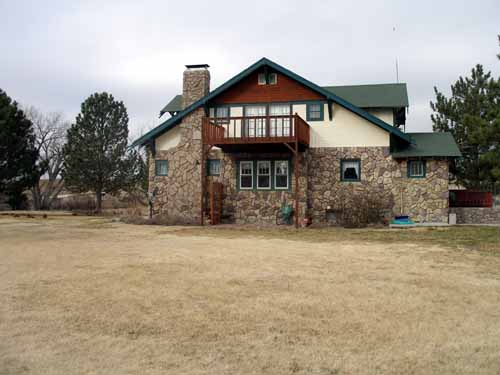 The Beaver Creek Ranch Lodge: main building can host up to six hunters during the season and has been wonderfully restored over the years with beautiful original oak floors and trim throughout the house.
The Beaver Creek Ranch Lodge: main building can host up to six hunters during the season and has been wonderfully restored over the years with beautiful original oak floors and trim throughout the house. 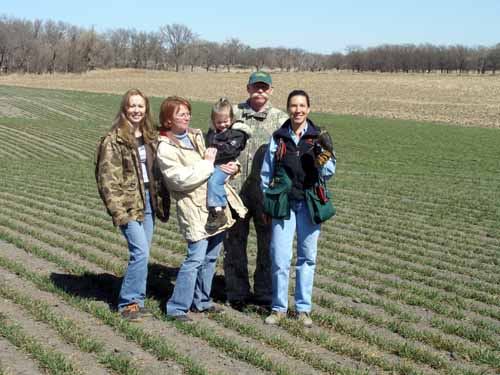 Right to Left: Anne Price with her Merlin, Jeff Hill, Alice Hill with her granddaughter Aiclynn, and Margaret, Aiclynn’s mom.
Right to Left: Anne Price with her Merlin, Jeff Hill, Alice Hill with her granddaughter Aiclynn, and Margaret, Aiclynn’s mom. 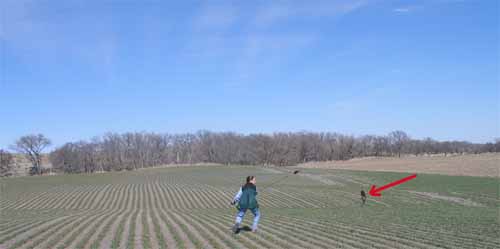 Anne Price, Master Falconer puts on a demonstration flight of her Merlin coming to the lure.
Anne Price, Master Falconer puts on a demonstration flight of her Merlin coming to the lure. 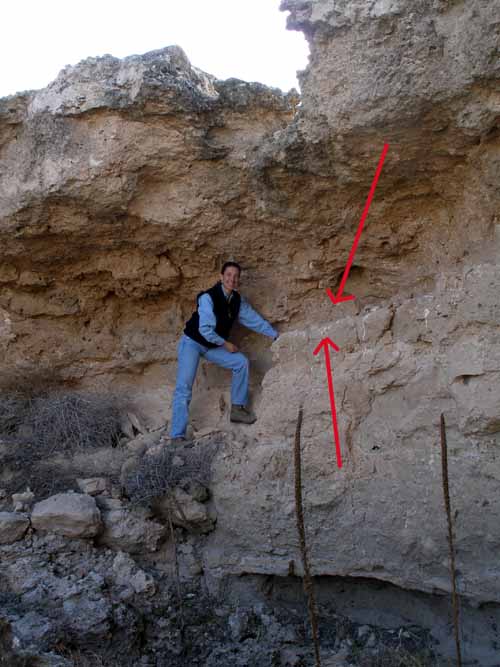 Anne Price, REF’s Curator of Raptors, inspects a prairie falcon aerie discovered while hiking the property during a preliminary assessment of game populations, habitat, cover, and other factors which need to be considered if the property is to host falconers and their birds. Stay tuned to our site. As our educational tour develops we will post dates, times
Anne Price, REF’s Curator of Raptors, inspects a prairie falcon aerie discovered while hiking the property during a preliminary assessment of game populations, habitat, cover, and other factors which need to be considered if the property is to host falconers and their birds. Stay tuned to our site. As our educational tour develops we will post dates, times
and locations.
In Alaska, Again
Continued from News Updates: Nineteen years ago, REF staff and birds spent several weeks cruising up and down Alaska’s Inside Passage with the first environmental raptor programs ever to be presented on board a ship. In 2005, once again, REF leads the way with exclusive programs for Alaska’s first and only private island experience for cruise ship passengers. Our northern adventure ended on September 10th. Enjoy some of the pictures below, as this story develops.
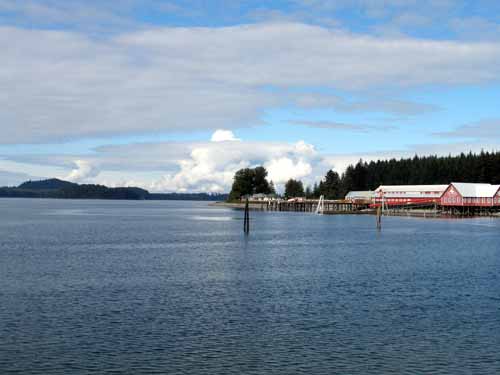 Icy Strait Point, located on Chichagof Island, is the first private island destination for the Alaskan cruise ship market. With a focus on low impact tourism, and more of an environmental educational experience, REF was engaged to design and develop a series of specialty programs to be presented at the Huna Native Theater and Museum. The image on the left shows the approach to the refurbished salmon cannery which is the disembarkation point for passengers as they are brought into the site.
Icy Strait Point, located on Chichagof Island, is the first private island destination for the Alaskan cruise ship market. With a focus on low impact tourism, and more of an environmental educational experience, REF was engaged to design and develop a series of specialty programs to be presented at the Huna Native Theater and Museum. The image on the left shows the approach to the refurbished salmon cannery which is the disembarkation point for passengers as they are brought into the site. 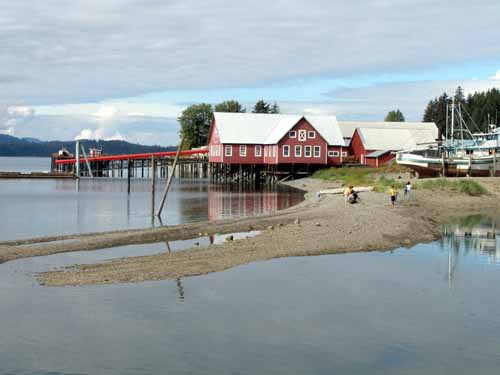 A closer view of the cannery as one approaches the site from the village of Hoonah.
A closer view of the cannery as one approaches the site from the village of Hoonah. 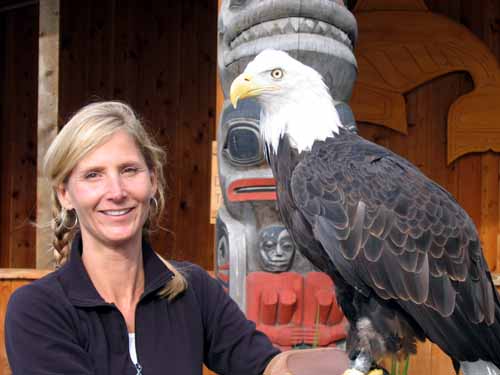 Jennifer McAllister, one of REF’s senior docents works with REF’s male bald eagle in front of the theater venue.
Jennifer McAllister, one of REF’s senior docents works with REF’s male bald eagle in front of the theater venue. 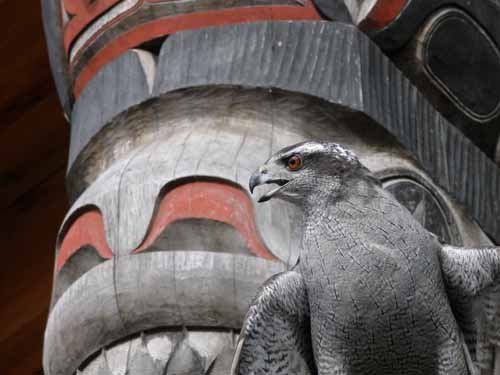 REF’s Northern Goshawk, brings the wildness of Alaska up close for guests who take the time to wander down one of the nature trials at Icy Strait Point.
REF’s Northern Goshawk, brings the wildness of Alaska up close for guests who take the time to wander down one of the nature trials at Icy Strait Point. 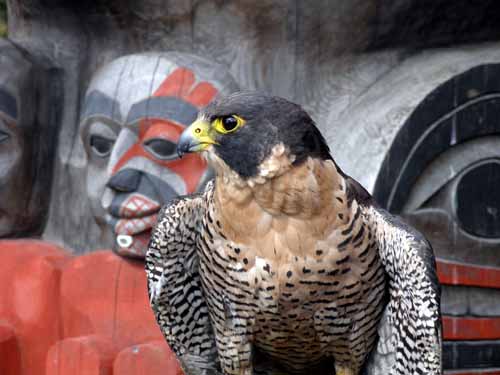 REF’s peregrine falcon was right at home inside or outside of the theater venue. While on the Kingfisher (below), and heading for the deep cold waters adjacent to Glacier Bay, a wild peregrine flew directly over our boat.
REF’s peregrine falcon was right at home inside or outside of the theater venue. While on the Kingfisher (below), and heading for the deep cold waters adjacent to Glacier Bay, a wild peregrine flew directly over our boat. 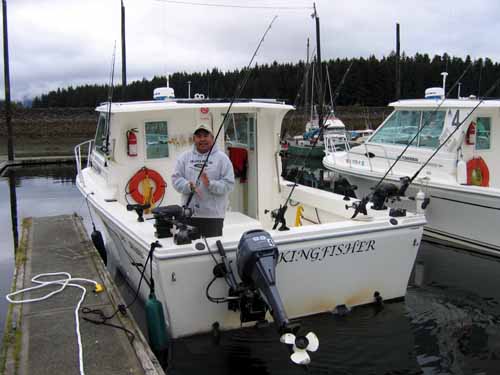 Captain of the Kingfisher, Duane A. Jack Sr., greets our crew as we get ready to come aboard for what turned out to be the adventure of a lifetime for many of us, again! Captain Jack and his family have been fishing Alaskan waters for generations, and know the science and art of catching fish with the best of them.
Captain of the Kingfisher, Duane A. Jack Sr., greets our crew as we get ready to come aboard for what turned out to be the adventure of a lifetime for many of us, again! Captain Jack and his family have been fishing Alaskan waters for generations, and know the science and art of catching fish with the best of them. 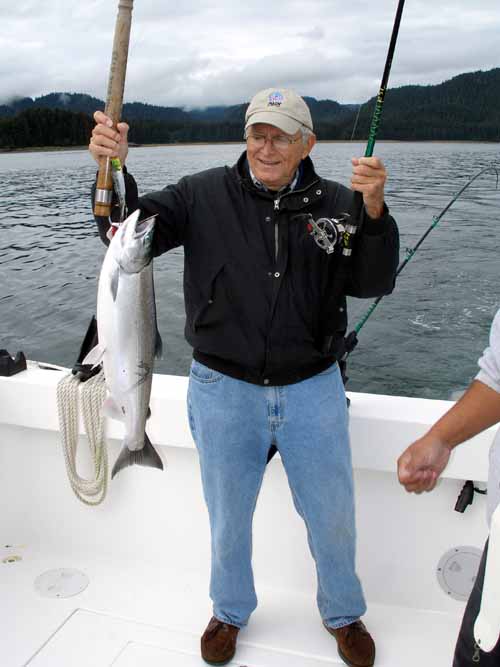 On days when the work load is lighter than normal, REF staff has been treated to some of the best fishing in the world. Here, senior docent, Bernie Gardetto lands a silver salmon at Point Adolphus near the entrance of Glacier Bay. REF Docents get the best adventures, just because they are the best in the business. The entire staff landed large salmon, and as you can see below, experienced some of the wildlife found in the icy waters. Interested in becoming one of REF’s elite Docents? Just click…
On days when the work load is lighter than normal, REF staff has been treated to some of the best fishing in the world. Here, senior docent, Bernie Gardetto lands a silver salmon at Point Adolphus near the entrance of Glacier Bay. REF Docents get the best adventures, just because they are the best in the business. The entire staff landed large salmon, and as you can see below, experienced some of the wildlife found in the icy waters. Interested in becoming one of REF’s elite Docents? Just click… 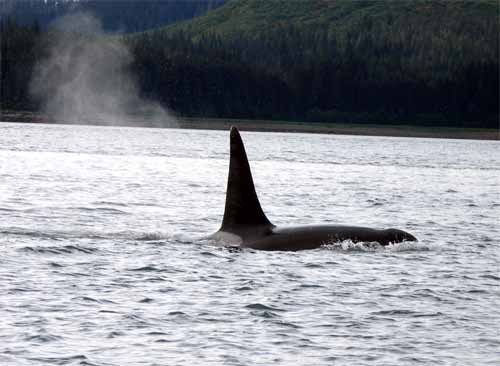 A male Orca (Killer Whale) rises just near our fishing boat. Pods of Orcas were seen just off of Icy Strait Point’s boardwalk providing guests on shore the remarkable opportunity to see these magnificent predators just a few hundred feet away.
A male Orca (Killer Whale) rises just near our fishing boat. Pods of Orcas were seen just off of Icy Strait Point’s boardwalk providing guests on shore the remarkable opportunity to see these magnificent predators just a few hundred feet away. 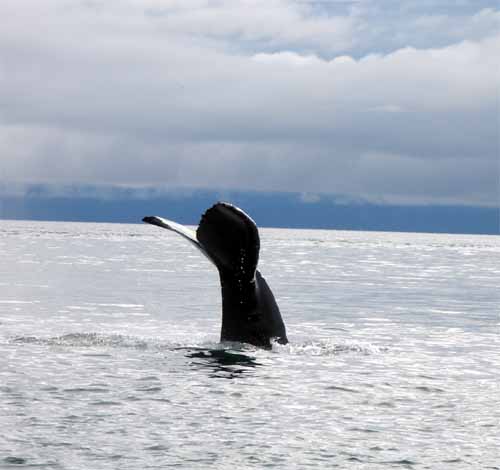 Point Adolphus, at the entrance to Glacier Bay, is one of the largest gathering areas of Humpback Whales in the world. While fishing, the REF staff was surrounded by multiple whales, just yards away.
Point Adolphus, at the entrance to Glacier Bay, is one of the largest gathering areas of Humpback Whales in the world. While fishing, the REF staff was surrounded by multiple whales, just yards away. 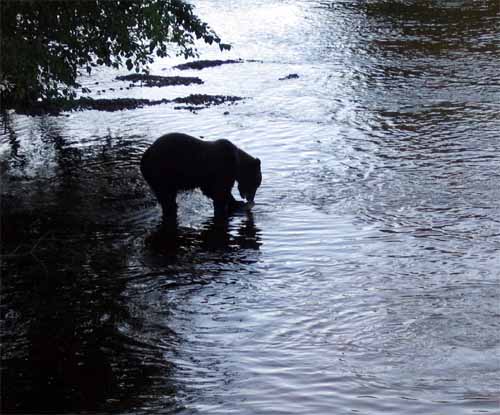 All those salmon means there are lots of brown bears enjoying plentiful free food as the spawning salmon give themselves up to the the ever present cycle of life and death. This was one of the smaller browns feeding in the Spasski River, as the REF staff was given an orientation tour of the entire site.
All those salmon means there are lots of brown bears enjoying plentiful free food as the spawning salmon give themselves up to the the ever present cycle of life and death. This was one of the smaller browns feeding in the Spasski River, as the REF staff was given an orientation tour of the entire site. 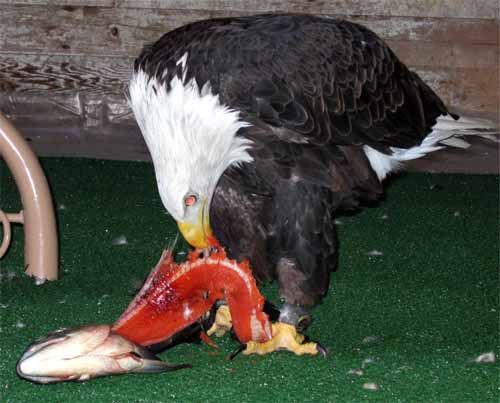 Not to be outdone for a taste of the local salmon, our bald eagle dines on a very fresh specimen. Note the very red meat (and the red eagle eye-flash), but also note that too much of a good thing, and our male bald went back to eating cotton tail rabbits we brought with us from Colorado. Probably too many of those Omega oils on his taste buds.
Not to be outdone for a taste of the local salmon, our bald eagle dines on a very fresh specimen. Note the very red meat (and the red eagle eye-flash), but also note that too much of a good thing, and our male bald went back to eating cotton tail rabbits we brought with us from Colorado. Probably too many of those Omega oils on his taste buds. 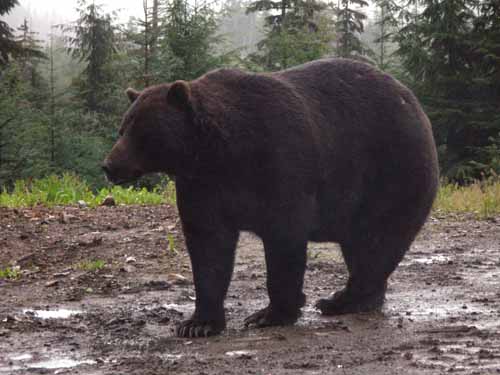 Somewhat closer to the village of Hoonah, near the municipal rubbish dump, this thousand pound plus monster was just a few yards away from our vehicle. Another larger bear was behind us, while two others scavenged on the third side of our van. We only had one exit, straight forward.
Somewhat closer to the village of Hoonah, near the municipal rubbish dump, this thousand pound plus monster was just a few yards away from our vehicle. Another larger bear was behind us, while two others scavenged on the third side of our van. We only had one exit, straight forward. 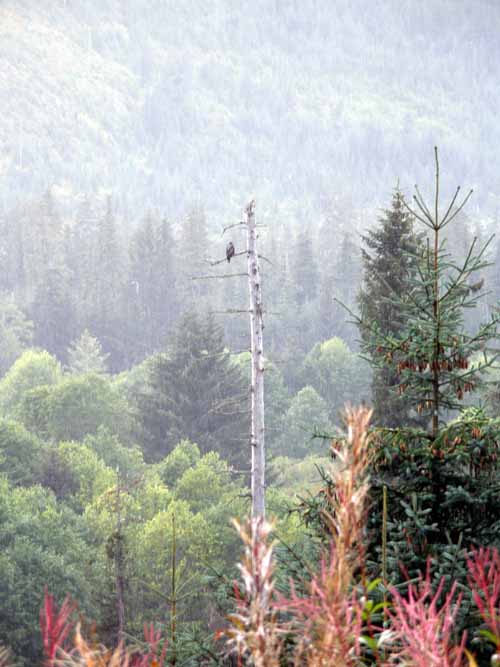 And of course, bald eagles are everywhere. Here an immature in the island’s interior is trying to wait out the gray rainy day, which as Alaskans say, is liquid sunshine. And there is lots of it over the Tongass National Forest, the largest temperate rain forest in the world.
And of course, bald eagles are everywhere. Here an immature in the island’s interior is trying to wait out the gray rainy day, which as Alaskans say, is liquid sunshine. And there is lots of it over the Tongass National Forest, the largest temperate rain forest in the world. 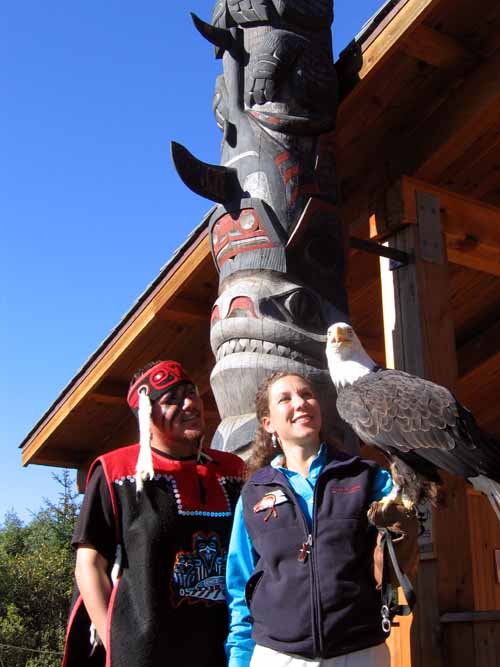 Howard Gray, Jr., Cultural Interpreter (dressed in traditional regalia) and Guide at Icy Strait Point, admires REF’s bald eagle held by Anne Price, Curator of Raptors at the end of our stay on Chichagof Island. Anne and Howard are pictured in front of the beautiful Huna Native Theater and Museum where all of REF’s programs were presented…see below.
Howard Gray, Jr., Cultural Interpreter (dressed in traditional regalia) and Guide at Icy Strait Point, admires REF’s bald eagle held by Anne Price, Curator of Raptors at the end of our stay on Chichagof Island. Anne and Howard are pictured in front of the beautiful Huna Native Theater and Museum where all of REF’s programs were presented…see below. 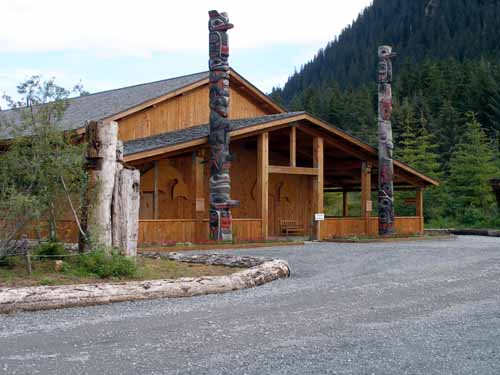 The beautiful theater and museum complex, made from local cedar and hemlock was home to REF’s programs and the Huna Tlingit cultural dancers (below), whose performances brought the living story of their history to guests from many states and foreign countries.
The beautiful theater and museum complex, made from local cedar and hemlock was home to REF’s programs and the Huna Tlingit cultural dancers (below), whose performances brought the living story of their history to guests from many states and foreign countries.  Finishing their performance, the dancers pose for photos and spend time talking with guests to answer a wide variety of questions.
Finishing their performance, the dancers pose for photos and spend time talking with guests to answer a wide variety of questions. 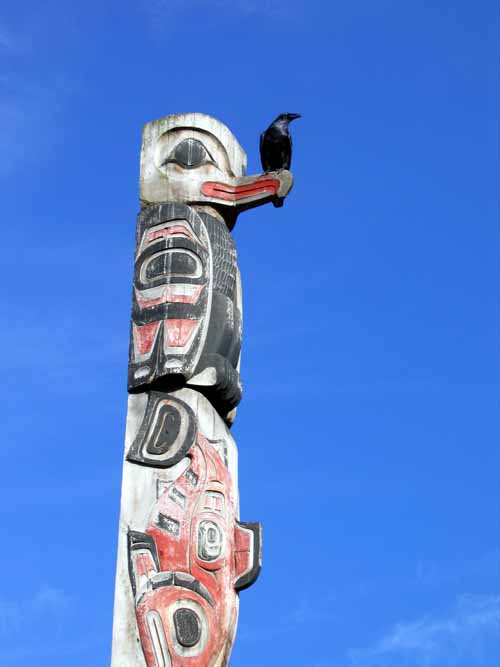 Together As One: A large Common Raven sits on top of one of the two totem poles outside the Huna Native Theater. Tlingit society in this region is divided into two groups, called “moieties”: the Raven and Eagle. Within each moiety are specific clans, such as Sea Lion, Thunderbird, Bear, etc. Both moieties are represented in each of these poles, and we managed to capture, for just a moment, this Alaskan-sized Raven at the top of the Eagle pole. Stay tuned as we update our tour with more pictures.
Together As One: A large Common Raven sits on top of one of the two totem poles outside the Huna Native Theater. Tlingit society in this region is divided into two groups, called “moieties”: the Raven and Eagle. Within each moiety are specific clans, such as Sea Lion, Thunderbird, Bear, etc. Both moieties are represented in each of these poles, and we managed to capture, for just a moment, this Alaskan-sized Raven at the top of the Eagle pole. Stay tuned as we update our tour with more pictures.
All photos: Jennifer McAllister, Anne Price & Peter Reshetniak
Dillon Nature Nights, 2005
 June 26, 2005 REF and its programs were back at the Town of Dillon amphitheatre for another “Nature Nights” program. Free flight, interaction, close-up viewing of beautiful birds keep bringing audiences back to our very popular one hour educational program year after year.
June 26, 2005 REF and its programs were back at the Town of Dillon amphitheatre for another “Nature Nights” program. Free flight, interaction, close-up viewing of beautiful birds keep bringing audiences back to our very popular one hour educational program year after year. 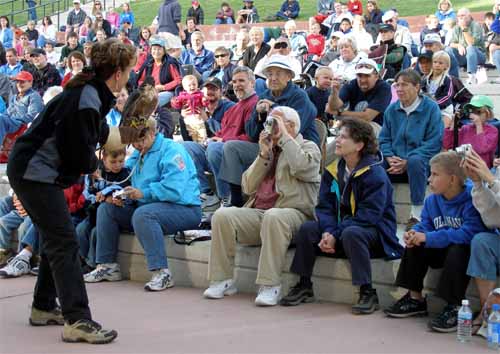 REF Docent, Toni Smith, features one of REF’s peregrine falcons for an up close visit.
REF Docent, Toni Smith, features one of REF’s peregrine falcons for an up close visit. 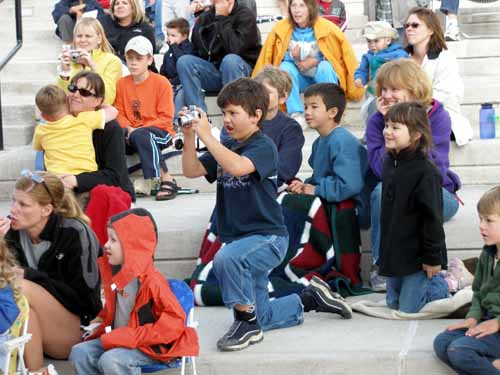 As we always say, “their faces tell our story.” Our programs always trigger intense curiosity, interest, and participation. The young man with his fish hat on (on our News Page) was role playing in the interactive program segment creating a “food web” or “biotic pyramid.” Family fun doesn’t get much better, which is part of our 25th Anniversary celebrations proving learning and fun can co-exist.
As we always say, “their faces tell our story.” Our programs always trigger intense curiosity, interest, and participation. The young man with his fish hat on (on our News Page) was role playing in the interactive program segment creating a “food web” or “biotic pyramid.” Family fun doesn’t get much better, which is part of our 25th Anniversary celebrations proving learning and fun can co-exist.
Spring, 2006, They’re Back…
Video: Our brand new feature allows us to show videos of what is going on with the wild baby great horned owls which fledged their nest on May 17th just a few yards away from our mews and the owls in our collection. Visit often to see updates. This first video was shot June 8, 2006. Scroll down for more pictures from this year and last year’s family history. Enjoy!
 June 9, 2006: The wild female great horned owl is never too far from her baby trio. While checking on the whereabouts of the young owls, the female broke out of one of the poplar trees next to our mews. She flew about 20 yards away and proceeded to keep her eyes on what the intruder was doing.
June 9, 2006: The wild female great horned owl is never too far from her baby trio. While checking on the whereabouts of the young owls, the female broke out of one of the poplar trees next to our mews. She flew about 20 yards away and proceeded to keep her eyes on what the intruder was doing.
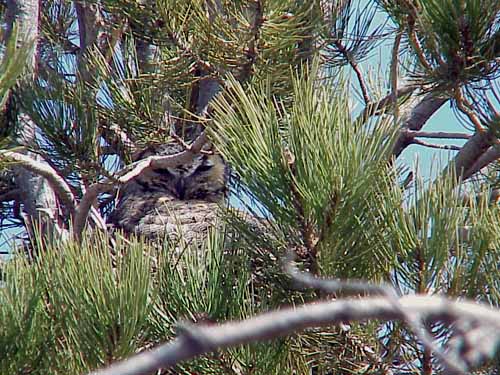 If you have been watching our site for the past year, then you have been privy to the wild Great Horned Owls that nested just about 50 feet away from our facility (see below). This year, the adults are back in the nest and here you see the female on the nest.
If you have been watching our site for the past year, then you have been privy to the wild Great Horned Owls that nested just about 50 feet away from our facility (see below). This year, the adults are back in the nest and here you see the female on the nest. 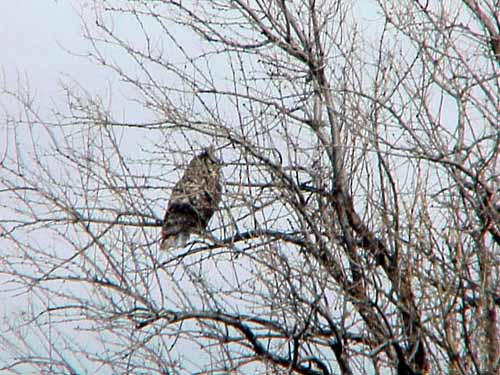 The male is never too far away from the nest. Despite being mobbed by a couple of very vocal flickers, this fellow did not go too far. Stay tuned as we watch for the first sign that the owlets have hatched. Meanwhile take a look at last years family.
The male is never too far away from the nest. Despite being mobbed by a couple of very vocal flickers, this fellow did not go too far. Stay tuned as we watch for the first sign that the owlets have hatched. Meanwhile take a look at last years family.
Baby Bubos Hanging Out
2005–We’re not sure the date they fledged their nest located just yards from our mews (bird barn), and when I walked to the base of the nest, I found numerous owl pellets (see below) indicating healthy eating habits, but no young owls. Walking back a few yards to the west side of our large owl enclosure, I found where the young great horned owls had moved to. They had simply moved to the much taller poplar trees located immediately next to our facility, and adjacent to our great horned owls. They are, in fact, sitting on top of our large owl enclosure. They seem to like hanging out next to our captive group, or maybe the wild parents are using our captive adults as baby sitters?(05/29/05) Most recent photos on top. More Virtual REF
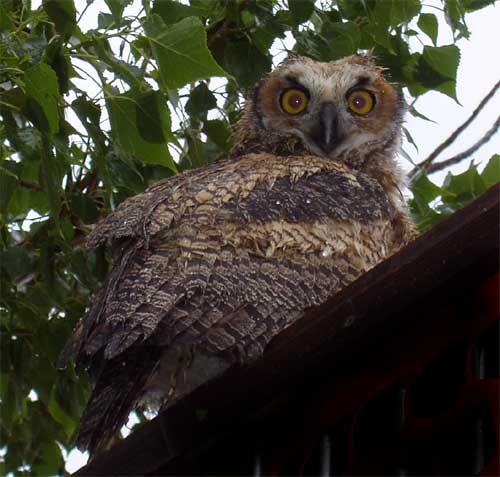 It’s wet out there!
It’s wet out there!
Marie Bolster photo
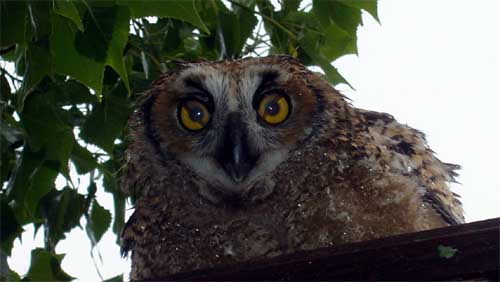 06/04/05 Several days with hard rain, wind, and hail have soaked our trio. This unusual shot by Marie Bolster not only reveals water droplets all over our young owl, but captures both nictatating membranes half-closed over the eyes. Windshield wipers working…
06/04/05 Several days with hard rain, wind, and hail have soaked our trio. This unusual shot by Marie Bolster not only reveals water droplets all over our young owl, but captures both nictatating membranes half-closed over the eyes. Windshield wipers working…  Marie Bolster photo
Marie Bolster photo 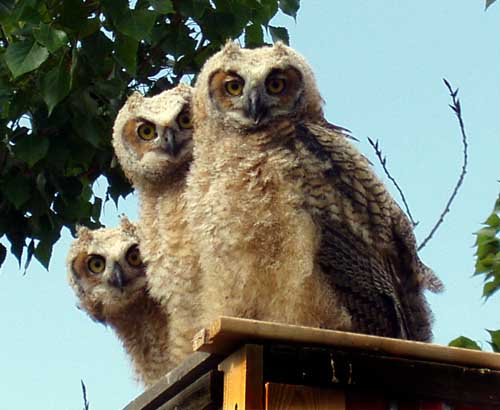 Visiting Director, Marie Bolster, captures this classic moment of our curious trio.
Visiting Director, Marie Bolster, captures this classic moment of our curious trio. 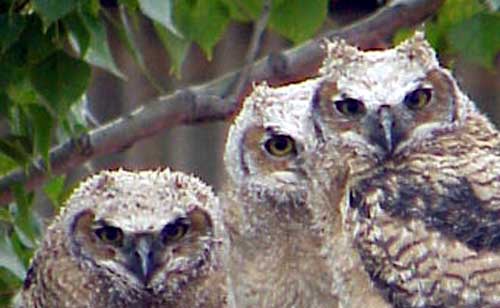 Larry, Curly, and Moe?
Larry, Curly, and Moe? 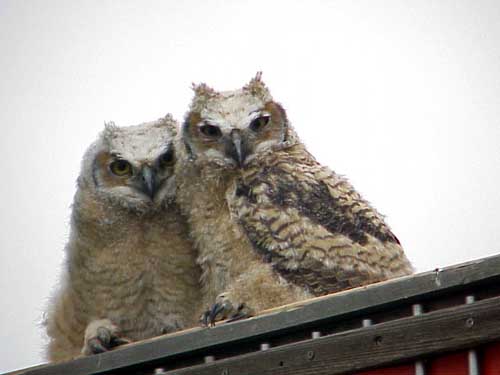 Hey, we are cute!
Hey, we are cute! 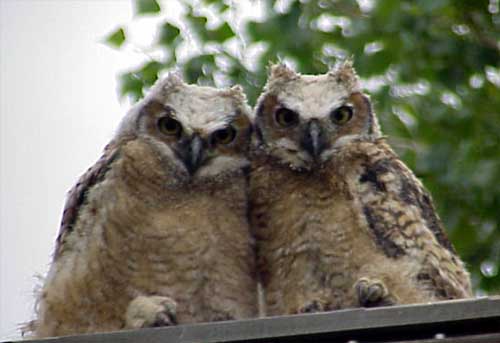 This is even cuter!
This is even cuter! 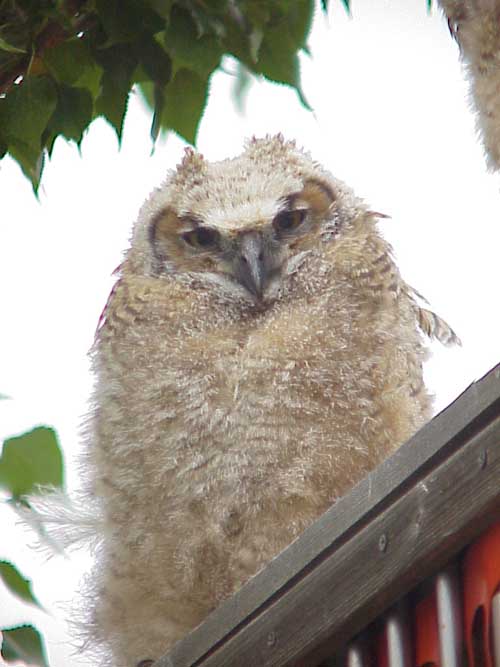 But solo, is the cutest of all
But solo, is the cutest of all 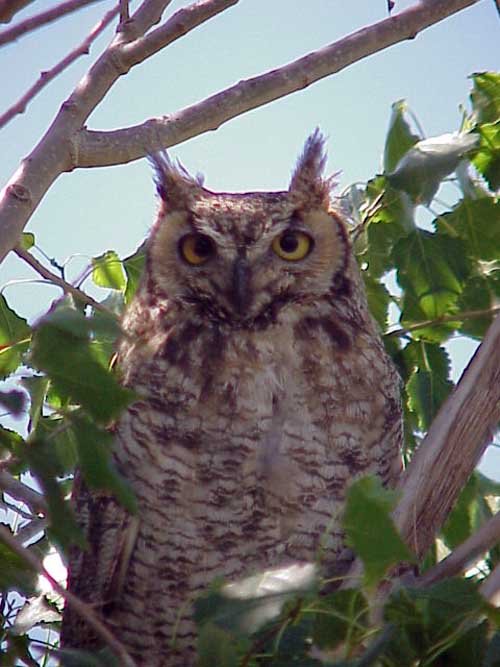 One of the parents, not so cute!
One of the parents, not so cute! 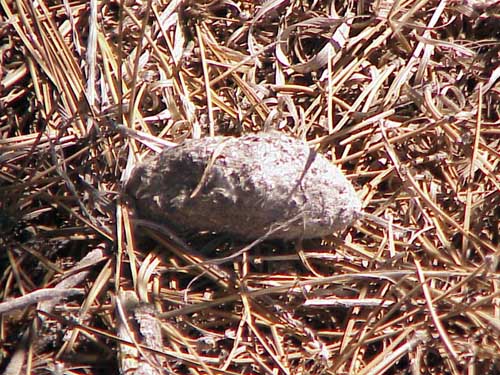 owl pellet (3 inches long)
owl pellet (3 inches long)
all photos by P. Reshetniak
If You Are Bubo, It Is Spring…
Early Easter in Our Owl Pen!
On Monday, March 14, we discovered that our female great horned owl had laid her very first egg. This female is at least 20 yrs old and possibly much older. Originally from the Scottsbluff area of Nebraska, we have been caring for her for 10 years. Two years ago we acquired a male great horned owl, and it is possible that his presence may have stimulated her nesting behavior. She made a scrape in the gravel in three separate corners of her enclosure; great horned owls do not build nests, they will often lay eggs in a cavity or directly on a cliff ledge like a falcon.
In preparation for her big event, she began spending most of her time at the scrape in the southeast corner of the owl enclosure. She also became very territorial and refused to allow anyone (raptor or human) near her domain. After a quick check and weighing by our Curator on March 14, we returned her to “nest” area.
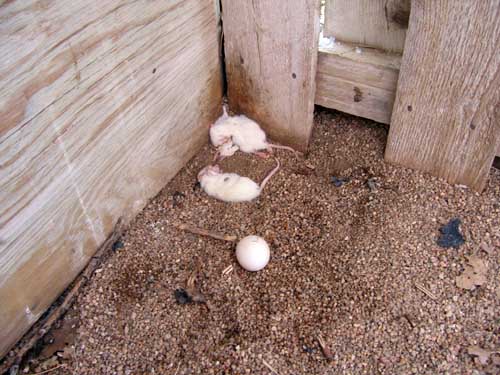
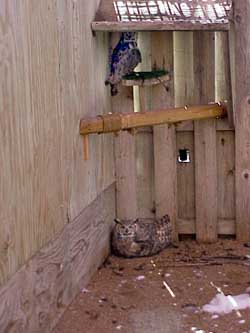 Just out of this enclosure, we have wild great horned owls who have decided to nest quite nearby. Maybe they have influenced our captive birds–maybe its in the air? See below…
Just out of this enclosure, we have wild great horned owls who have decided to nest quite nearby. Maybe they have influenced our captive birds–maybe its in the air? See below…
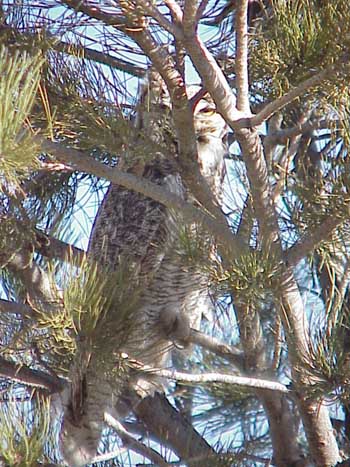 Just a few feet from our facility on the eastern high prairie of Colorado, a pair of wild Great Horned Owls have set up house in an old magpie nest. Both male and female are seen regularly near the nest, but no incubation has been noted at this date.
Just a few feet from our facility on the eastern high prairie of Colorado, a pair of wild Great Horned Owls have set up house in an old magpie nest. Both male and female are seen regularly near the nest, but no incubation has been noted at this date. 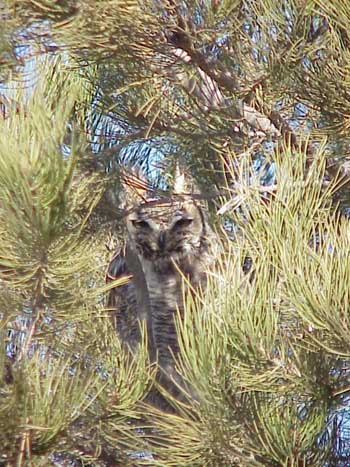 With the wind blowing, it is easy to lose the owl in the swaying branches…but he is there. More Virtual REF
With the wind blowing, it is easy to lose the owl in the swaying branches…but he is there. More Virtual REF
Home AdoptARaptor Calendar ConsultingServices Eco-Mewsings
Meet our Raptors Membership News
OurHeroes Products Programs TheRaptorCollection VolunteerOpportunties
CoolHotLinks ContactUs
Copyright Raptor Education Foundation.
All Pages, All rights reserved.
Raptor Education Foundation is a Registered Trademark.
Last revised: December 08, 2010
